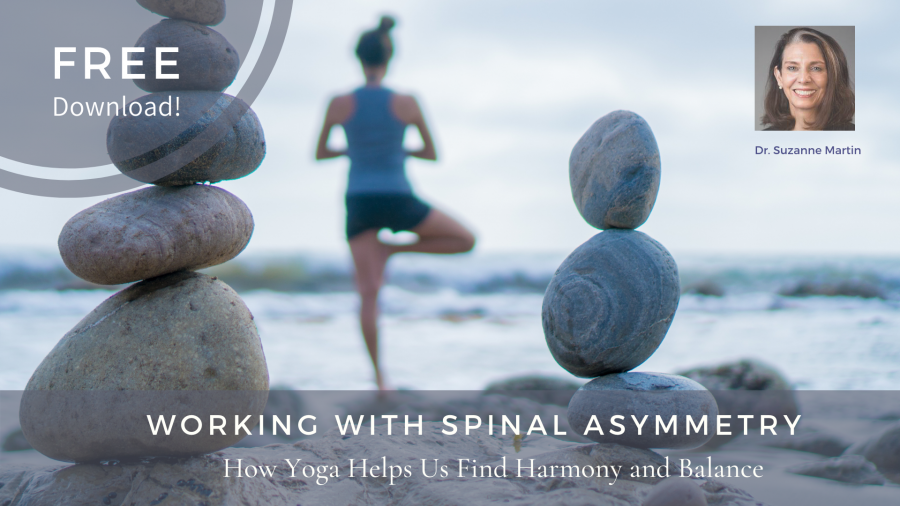Free Download! Working with Spinal Asymmetry: How Yoga Helps Us Find Harmony and Balance
Course Info
- Price:
- $0.00
Dr Suzanne Martin
 Dr. Suzanne Martin is an international speaker, coach and mentor in the field of human movement and potential. As a doctor of physical therapy, exercise physiology and gold-certified Pilates expert, she authored three movement titles with Penguin Books and a fourth in 2018, Spinal Asymmetry and...
Dr. Suzanne Martin is an international speaker, coach and mentor in the field of human movement and potential. As a doctor of physical therapy, exercise physiology and gold-certified Pilates expert, she authored three movement titles with Penguin Books and a fourth in 2018, Spinal Asymmetry and... 
When it comes to movement potential in the presence of a spinal asymmetry, such as scoliosis, is anatomy destiny? Is limited movement and chronic pain a given?
Not necessarily, says Dr. Suzanne Martin, physical therapist, gold-certified Pilates expert and author of the book Spinal Asymmetry and Scoliosis: Movement and Function Solutions for the Spine, Ribcage and Pelvis.
In this free download interview, Suzanne, a former dancer, talks about how her work evolved from being a performer to becoming a movement specialist when she discovered an underlying scoliosis in her own spine. She now trains others, both people with spinal asymmetry and movement professionals to increase their movement potential in the presence of spinal asymmetry.
Suzanne explains how working to reorganize the fascial network – the fibrous connective tissue that covers every cell in the body – can unlock movement in any body.
While Pilates helped her to create the core stability needed to support her spine, learning the manual technique of fascial release opened her awareness to the role the fascial network can play in unlocking more healthy movement potential. “The body can have so much more structural integrity as a result of healthy soft tissue organization,” she explains.
“Fascial release – called the soft techniques – can create so much structural integrity. Understanding how to activate the fascial slings can give us way more strength and organization. Even with a super structural condition like scoliosis, you can still find a way to activate the functional parts and move well,” she continues.
Suzanne describes the uniqueness and enormity of variability between one body and another. She points out how looking at the central spinal vertical line from the back, one might be tempted to think asymmetry is the norm. But the internal body, which houses the organs, is actually quite asymmetrical. So what we’re really looking for in our very typically asymmetrical bodies is not symmetry, but rather harmony.
As for what causes spinal asymmetries, Suzanne points out that the causes can be as varied as genetics, the physiology of the aging process, a growth spurt, life events such as childbirth, and something a bit surprising, dominant handedness. (Most of us are righty’s!)
The irregular shape of our spines can be a function of genetics and can go unnoticed for years, due to the body’s ability to compensate around a rotation in the spine, making it feel normal. Sometimes we don’t even know about it until chronic pain sets in.
Suzanne counsels that managing an asymmetrical spine toward pain-free and functional movement is doable, but it’s a life-long process that requires an informed approach. She points out how common daily movements that involve twisting, such as sweeping a drive, can cause the soft tissue to model into the very curve patterns we want to resolve. And it’s natural for the curve to increase with age.
The many tools of yoga – targeted breath practice, mindful movement, meditative reflection – provide powerful support in addressing issues of the spine. Awareness, acceptance, and a receptiveness to working with what is are qualities we endeavor to cultivate in yoga that can also lead to a more successful approach to working with spinal asymmetry.
Perhaps surprisingly, Suzanne points out that correcting the curve may not be a top priority in working with scoliosis. To retain functional movement and the ability to walk it’s more important to shore up the spine as is, strengthening the muscles around the lumbar spine, while taking the curve into account. “There are parts of this spinal asymmetry that you can change and there are going to be parts you can’t change,” Suzanne says.
“We’ve got this skeleton that may not be quite right, and then we have all this muscle and connective tissue on top of it. The fascia is like the great connector that can bring a person to balance. If we can find the lines of pull and create sustained lines of tension, that’s what’s really needed. And yoga does that really well,” she says. She points out how unlike other healing modalities, such as pilates or PT, yoga offers people with spinal asymmetry time for inner learning. Whereas a scoliosis flare up can send a person into a panic, a regular yoga practice can tap into the parasympathetic nervous system, the rest and restore function, to bring on a calming effect.
“Yoga gives us time to hook into the somatic, rather than a corrective component,” Suzanne states. “It engages the entire body and gives time to connect past the imagery of spinal asymmetry and bring on a nonjudgmental self-acceptance helping to develop our best self.”